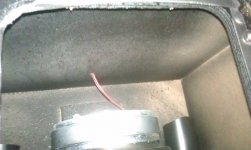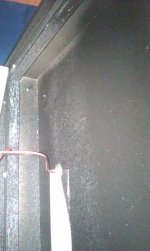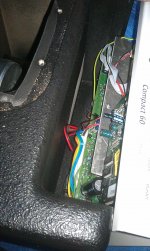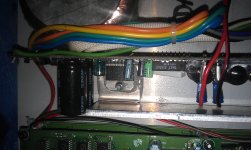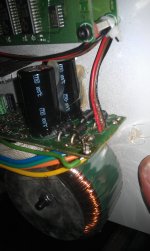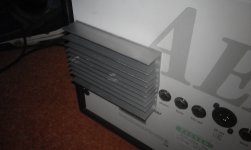I am currently looking at this amp after being told that it suffers from cutting out after an hour or so. I cannot get hold of a service manual for it so it's a case of running several tests and looking around to see what's going on inside.
On closer inspection, I found that the bleed resistor had gone open circuit. Not that this would affect the actual operation of the amp. I put a new one in and it burnt out straight away. Not sure why this is happening.
I also found that the main amplifier chip on the board attached to a large heatsink is a TDA7294. This chip has a thermal overload protection built in so I think this is what is operating and causing the amp to cut the sound output (the power light stays on when it shuts down).
I could not get the amp to shut down when I was running my hifi tuner into it for well over 4 hours yesterday. It only shuts down when a guitar is playing through it.
I am thinking of replacing the TDA7294 as I suspect it might be damaged and thus activating its protection circuit prematurely. My friend says that his band member has exactly the same amp and his does not run as hot as my friend's one after an hour of playing.
Any ideas on this one?
On closer inspection, I found that the bleed resistor had gone open circuit. Not that this would affect the actual operation of the amp. I put a new one in and it burnt out straight away. Not sure why this is happening.
I also found that the main amplifier chip on the board attached to a large heatsink is a TDA7294. This chip has a thermal overload protection built in so I think this is what is operating and causing the amp to cut the sound output (the power light stays on when it shuts down).
I could not get the amp to shut down when I was running my hifi tuner into it for well over 4 hours yesterday. It only shuts down when a guitar is playing through it.
I am thinking of replacing the TDA7294 as I suspect it might be damaged and thus activating its protection circuit prematurely. My friend says that his band member has exactly the same amp and his does not run as hot as my friend's one after an hour of playing.
Any ideas on this one?
Hi everyone, I have had a look through articles relating to chip amps and bleed resistors. Just need to also know if there is a relatively easy way to calculate the correct bleed resistor value and wattage. It was hard to see what the value of the blown bleed resistor was - as it burnt the casing somewhat and almost took out a small capacitor (!). I have attached photos for reference. Power caps are 4700uF each at 35V.
The distributors for AER are not prepared to provide me with a schematic. Instead, they have quoted £48 per hour just to look at it and £10.60 carriage. Well, I am certainly not doing that!
I am thinking of getting hold of a PC case fan or similar and running it off the DC positive and negative rails at the rectifier diodes (approx 30V). This looks like the easiest place to draw DC power from. The challenge will be to mount it in such a way so as to most effectively cool the TDA7294 IC. There isn't much room in there, so I think I might have to be creative as to how I direct the airflow from the fan and where to put the exhaust. I am thinking to blow air from one side of the amp casing to the other side. So I would mount the fan from behind the PCB where the speaker is and then install an exhaust on the side where the PCB is. A control board to switch the fan on and off when it got to a certain temperature would also be handy.
Any tips as to how best to mount the fan, suggested circuit layout and exhaust etc is appreciated. I think I might be able to buy a decent fan temperature switch circuit from ebay. The only other thing I can think of is potential electrical "noise" of the fan causing a problem....I am not 100% sure on how I could limit this "noise"....
The distributors for AER are not prepared to provide me with a schematic. Instead, they have quoted £48 per hour just to look at it and £10.60 carriage. Well, I am certainly not doing that!
I am thinking of getting hold of a PC case fan or similar and running it off the DC positive and negative rails at the rectifier diodes (approx 30V). This looks like the easiest place to draw DC power from. The challenge will be to mount it in such a way so as to most effectively cool the TDA7294 IC. There isn't much room in there, so I think I might have to be creative as to how I direct the airflow from the fan and where to put the exhaust. I am thinking to blow air from one side of the amp casing to the other side. So I would mount the fan from behind the PCB where the speaker is and then install an exhaust on the side where the PCB is. A control board to switch the fan on and off when it got to a certain temperature would also be handy.
Any tips as to how best to mount the fan, suggested circuit layout and exhaust etc is appreciated. I think I might be able to buy a decent fan temperature switch circuit from ebay. The only other thing I can think of is potential electrical "noise" of the fan causing a problem....I am not 100% sure on how I could limit this "noise"....
Attachments
The other option could be to pop a larger heatsink on the back of the amp - bolted through the casing. The IC uses the back of the amp to further dissipate the heat. Perhaps a large heatsink on the back of the amp might help with drawing heat away and thus avoid the need for putting a fan in there?
I think the resistor that was right next to the power caps was the bleed resistor. Bleeder resistor - Wikipedia, the free encyclopedia
sorry Homer moment...doh
if the bleeder resistor in the supply section is cooking i'd suspect that this unit is breaking into high frequency oscillation (which is also a likely source of the original complaint: shutting down thermally) time to break out the o'scope or contemplate replacing the main filters.
100k as a value for bleeder
if the bleeder resistor in the supply section is cooking i'd suspect that this unit is breaking into high frequency oscillation (which is also a likely source of the original complaint: shutting down thermally) time to break out the o'scope or contemplate replacing the main filters.
100k as a value for bleeder
Last edited:
Aha - I think you have nailed it! This could certainly explain the shutting down. This would also explain why it doesn't ever shut down when I put my hifi tuner into it and only shuts down when a guitar is fed through it. I don't yet have a scope (getting ever closer though!) so instead I think I will go ahead and replace those power caps. From memory, they seemed fine when I tested them on the ESR meter. Better be safe than sorry though. All rectifier diodes tested OK. Any particular caps I should be getting? I usually buy Panasonic ones from a reputable supplier.
respect temp ratings on the caps or uprate. and without a schematic it's hard to say but if the output of the chipamp has a Zobel make sure it's ok that could be another reason it might be oscillating.
sorry i was editing the previous post but in case you didn't catch it 100k should work.
sorry i was editing the previous post but in case you didn't catch it 100k should work.
I read the colour code on the original bleed resistor (it wasn't easy as it was somewhat burnt) as 10ohms. It looked like a 0.6w resistor. 10 ohms seemed much too low. Sure enough, when I replaced it with a 3W rated 10 ohm resistor, the resistor glowed hot like an element and almost set fire to the board! Thank goodness that I saw it quick enough to cut the power.
Update on progress - I measured all the caps and they were within ESR limits, so I popped a large heatsink on the back of the unit using the same bolt which currently goes through the metal bit of TDA7294. I then put another bolt in line with that one and put thermal paste behind the heatsink where it contacts the back casing. Not sure if this will work but there's only one way to find out - time to get my mate to put his guitar through it!
Attachments
- Home
- Live Sound
- PA Systems
- AER Compact 60 amplifier overheating problem
